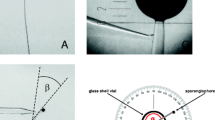Abstract
Dikegulac sodium 2,3:4,6 di-O-isopropylidene-2-keto-L-gulonate) is a translocatable agent used for chemically ‘pinching’ terminal buds to break apical dominance. It does not inhibit mature leaves. Cell culture systems were developed and used to ascertain whether or not it differentially inhibits green tissue and whether or not it differentially inhibits stationary cells at the concentrations used. A differential inhibition of dividing cells was found.
Similar content being viewed by others
Abbreviations
- FDA:
-
fluorescein diacetate
References
Arzee, T., Langenauer, H., Gressel, J.: Effects of dikegulac, a new growth regulator, on apical growth and development of three Compositae. Bot. Gaz. 138, 18–28 (1977)
Bocion, P.F., de Silva, W.H.: Group of new chemicals with plant growth regulatory activity. Nature 258, 142–143 (1975)
Gressel, J., Cohen, N.: Effects of dikegulac, a new growth regulator, on RNA synthesis in Spirodela. Plant & Cell Physiol. 18, 255–259 (1977)
Rosner, A., Porath, D., Gressel, J.: The distribution of plastid ribosomes and integrity of plastid ribosomal RNA during greening and maturation of Spirodela fronds. Plant & Cell Physiol. 15, 891–902 (1974)
Rubin, G., Zaitlin, M.: Cell concentration as a factor in precursor incorporation by tobacco leaf protoplasts of separated cells. Planta 131, 87–89 (1976)
Sill, L.Z., Nelson, P.V.: Relationship between azalea bud morphology and effectiveness of methyl decanoate, a chemical pinching agent. J. Amer. Soc. Hort. Sci. 95, 270–273 (1970)
de Silva, W.H., Bocion, P.F., Walter, H.R.: Chemical pinching of azalea with dikegulac. Hort. Sci. 11, 569–570 (1976)
Zilkah, S., Bocion, P.F., Gressel, J.: Cell cultures vs. whole plants for measuring phytotoxicity. II. Correlations between phytotoxicity in seedings and calli. Plant & Cell Physiol. 18, 657–670 (1977)
Zilkah, S., Gressel, J.: Cell cultures vs. whole plants for measuring phytotoxicity. I. The establishment and growth of callus and suspension cultures and definition of factors affecting toxicity. Plant & Cell Physiol. 18, 641–655 (1977a)
Zilkah, S., Gressel, J.: Cell cultures vs. whole plants for measuring phytotoxicity. III. Correlations between phytotoxicities in cell suspension cultures, calli and seedlings. Plant & Cell Physiol. 18, 815–820 (1977b)
Zilkah, S., Gressel, J.: Correlations in phytotoxicity between white and green calli of Rumex obtusifolius, Nicotiana tabacum and Lycoperiscon esculentum. Pest. Biochem. Physiol. in press (1978a)
Zilkah, S., Gressel, J.: The estimation of plant cell death evoked by phytotoxic compounds; differences among techniques. Plant Sci. Lett. in press (1978b)
Author information
Authors and Affiliations
Rights and permissions
About this article
Cite this article
Zilkah, S., Gressel, J. Differential inhibition by dikegulac of dividing and stationary cells in in vitro cultures. Planta 142, 281–285 (1978). https://doi.org/10.1007/BF00385078
Received:
Accepted:
Issue Date:
DOI: https://doi.org/10.1007/BF00385078




